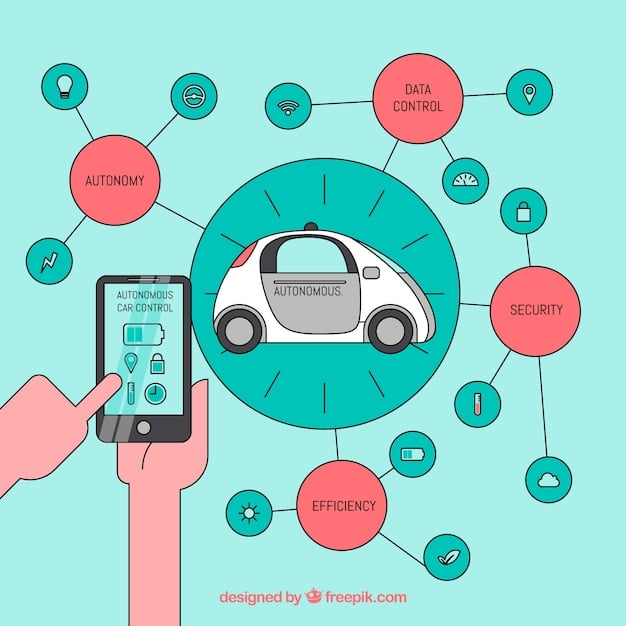Connected Cars: How 5G Will Revolutionize US Traffic Management

Connected car technology, enhanced by 5G integration, is poised to transform real-time traffic management across the US by enabling faster data transmission, improved communication between vehicles and infrastructure, and more efficient navigation, ultimately reducing congestion and enhancing safety.
Imagine a future where traffic jams are relics of the past, and commutes are seamless, efficient, and safe. This vision is becoming increasingly attainable thanks to the convergence of connected car technology and the power of 5G integration, promising to revolutionize real-time traffic management across the US.
Connected Cars and the Promise of 5G
The automotive industry is undergoing a significant transformation with the rise of connected cars. These vehicles are equipped with advanced sensors, software, and communication capabilities, allowing them to interact with their surroundings and other vehicles. When coupled with the ultra-fast and low-latency capabilities of 5G networks, connected car technology has the potential to revolutionize how we manage traffic and navigate our roads.
5G technology offers several key advantages over previous generations of mobile networks. Its significantly faster speeds enable the near-instantaneous transmission of vast amounts of data. Lower latency, the delay between sending and receiving information, is crucial for real-time applications like traffic management. Greater network capacity allows for more devices to be connected simultaneously without compromising performance.
The Building Blocks of a Connected Car
Connected cars rely on a suite of complex technologies to function effectively. These components work in concert to gather, process, and share information, creating a dynamic and interconnected transportation ecosystem.
- Sensors and Data Collection: Cameras, radar, lidar, and ultrasonic sensors constantly monitor the car’s surroundings, collecting data on traffic flow, road conditions, and the presence of other vehicles.
- Vehicle-to-Everything (V2X) Communication: This allows cars to communicate with other vehicles (V2V), infrastructure (V2I), pedestrians (V2P), and networks (V2N), sharing critical information in real-time.
- Onboard Computing Power: Sophisticated processors analyze the data collected and make decisions about navigation, safety, and performance.
In essence, connected car technology leverages these elements to create a comprehensive and responsive driving experience. By combining these technologies with 5G’s robust capabilities, the potential for safer and more efficient transportation becomes significantly enhanced.

Real-Time Traffic Management: A 5G-Enabled Revolution
Traditional traffic management systems rely on static data and historical trends, which often fail to account for unexpected events or rapidly changing conditions. 5G-integrated connected car technology offers a dynamic, real-time approach to traffic management that can adapt to ever-changing circumstances.
With 5G’s high bandwidth and low latency, connected cars can transmit and receive data almost instantaneously. This real-time information flow allows traffic management systems to gain a holistic view of road conditions, identify bottlenecks, and proactively implement strategies to alleviate congestion. Imagine intelligent traffic lights that adjust their timing based on the actual flow of vehicles, or dynamic rerouting that guides drivers away from accidents or construction zones.
Benefits of 5G-Enabled Real-Time Traffic Management
The integration of 5G and connected car technology brings a wealth of benefits to traffic management, leading to a more efficient, safer, and sustainable transportation ecosystem.
- Reduced Congestion: Real-time data and adaptive traffic management strategies can minimize bottlenecks and optimize traffic flow, significantly reducing congestion.
- Improved Safety: V2X communication and advanced driver-assistance systems (ADAS) can warn drivers of potential hazards, prevent accidents, and improve overall road safety.
- Enhanced Efficiency: Optimized routes and reduced travel times can save fuel, lower emissions, and improve the overall efficiency of transportation.
- Data-Driven Decision Making: The vast amounts of data generated by connected cars can be analyzed to identify trends, predict future traffic patterns, and inform infrastructure planning.
Ultimately, 5G-enabled real-time traffic management has the potential to transform urban mobility, creating smarter, more responsive, and more sustainable transportation systems.
5G and V2X Communication: The Backbone of Intelligent Transportation
Vehicle-to-Everything (V2X) communication is a critical component of connected car technology, enabling vehicles to interact with their surroundings and share vital information. 5G plays a crucial role in facilitating reliable V2X communication, enabling a wide range of applications that enhance safety, efficiency, and convenience.
V2X communication encompasses several different types of interactions, including:
- Vehicle-to-Vehicle (V2V): Cars exchange information about their speed, location, and direction, enabling cooperative driving and collision avoidance.
- Vehicle-to-Infrastructure (V2I): Cars communicate with traffic lights, road signs, and other infrastructure elements, receiving real-time information about road conditions and traffic regulations.
- Vehicle-to-Pedestrian (V2P): Cars can detect pedestrians and cyclists, providing warnings to both drivers and vulnerable road users.
- Vehicle-to-Network (V2N): Cars connect to cloud-based services and data centers, accessing real-time traffic information, navigation updates, and entertainment.
With 5G’s low latency and high bandwidth, V2X communication becomes more reliable and responsive, enabling faster reaction times and more effective safety features. This technology could significantly reduce accidents by providing drivers with advanced warnings of potential hazards.
Examples of V2X Applications Enabled by 5G
The combination of 5G and V2X unlocks a range of applications that have the potential to revolutionize transportation:
- Cooperative Adaptive Cruise Control: Cars automatically adjust their speed and spacing based on the movements of other vehicles, maintaining a safe and efficient flow of traffic.
- Emergency Electronic Brake Light: A car that brakes suddenly sends a warning signal to nearby vehicles, giving them more time to react and avoid a collision.
- Intersection Collision Warning: Cars approaching an intersection receive warnings if there is a high risk of a collision, allowing them to take evasive action.
The possibilities are vast, and as 5G networks continue to expand, we can expect to see even more innovative V2X applications emerge, further enhancing the safety and efficiency of our roads.
Addressing Challenges and Ensuring Security in a 5G-Connected World
While the integration of 5G and connected car technology offers numerous benefits, it also presents several challenges that must be addressed to ensure the safe, reliable, and secure operation of these systems.
One of the primary challenges is cybersecurity. As cars become increasingly connected, they become more vulnerable to cyberattacks. Hackers could potentially gain control of vehicle systems, steal personal data, or disrupt traffic flow. Therefore, robust security measures must be implemented to protect connected cars from cyber threats. This includes secure communication protocols, intrusion detection systems, and over-the-air software updates to patch vulnerabilities.
Key Considerations for Security and Reliability
Ensuring the security and reliability of 5G-connected car systems requires a multi-faceted approach:
- Data Privacy: Protecting the privacy of driver and passenger data is crucial. Strong data encryption and anonymization techniques should be employed to prevent unauthorized access and misuse of personal information.
- Network Reliability: 5G networks must be reliable and resilient to ensure uninterrupted connectivity for connected cars. Redundant infrastructure and backup systems can help to minimize downtime and maintain critical communication links.
- Interoperability: Ensuring interoperability between different car manufacturers and infrastructure providers is essential for seamless V2X communication. Standardized communication protocols and data formats can facilitate interoperability and prevent fragmentation of the connected car ecosystem.
Overcoming these challenges is crucial to realizing the full potential of 5G-connected car technology and building a safe and trustworthy transportation future. Collaboration between automakers, technology companies, and government agencies is essential.

The Economic and Societal Impact of 5G-Enabled Traffic Management
The widespread adoption of 5G-enabled connected car technology has the potential to generate significant economic and societal benefits, transforming not only how we travel but also how we live and work.
From an economic perspective, reduced congestion and improved traffic flow can lead to significant cost savings. Businesses can benefit from lower transportation costs, faster delivery times, and increased productivity. Consumers can save time and money on fuel, vehicle maintenance, and insurance. Furthermore, the development and deployment of 5G-connected car technologies can create new jobs and stimulate economic growth.
Societal Benefits of Connected Car Technology
The societal impacts of 5G-enabled traffic management are equally profound:
- Reduced Accidents: Advanced safety features and V2X communication can significantly reduce the number of accidents and injuries on our roads.
- Improved Air Quality: Reduced congestion and optimized traffic flow can lower emissions and improve air quality in urban areas.
- Enhanced Accessibility: Connected car technology can improve accessibility for people with disabilities, providing them with greater independence and mobility.
By creating a safer, more efficient, and more sustainable transportation system, 5G-enabled traffic management can contribute to a better quality of life for all.
The Future of Transportation: A 5G-Powered Vision
Looking ahead, the future of transportation is inextricably linked to the continued evolution of 5G and connected car technology. As 5G networks become more ubiquitous and sophisticated, we can expect to see even more innovative applications emerge, transforming the way we move people and goods.
One of the most exciting trends is the development of autonomous vehicles. Self-driving cars rely heavily on connected car technology and 5G connectivity to navigate their surroundings, communicate with other vehicles, and make real-time decisions. As autonomous driving technology matures, it has the potential to revolutionize transportation, making it safer, more efficient, and more accessible.
Beyond autonomous vehicles, we can also expect to see advancements in areas such as:
- Smart Infrastructure: Traffic lights, road signs, and other infrastructure elements will become increasingly connected, providing real-time information to drivers and autonomous vehicles.
- Predictive Traffic Management: Advanced analytics and machine learning will be used to predict traffic patterns and proactively manage traffic flow.
- Personalized Mobility Services: Mobility-as-a-Service (MaaS) platforms will integrate with connected car technology to provide personalized transportation solutions tailored to individual needs.
The road ahead is full of possibilities, and the integration of 5G and connected car technology promises to reshape the future of transportation in profound and transformative ways.
| Key Benefit | Brief Description |
|---|---|
| 🚀 Reduced Congestion | Real-time data and adaptive strategies minimize traffic bottlenecks. |
| 🛡️ Improved Safety | V2X communication warns drivers of potential hazards, preventing accidents. |
| 💨 Enhanced Efficiency | Optimized routes and reduced travel times save fuel and lower emissions. |
| 📊 Data-Driven Decisions | Analysis of connected car data informs better infrastructure planning. |
FAQ
▼
A connected car is equipped with internet access, sensors, and advanced software to communicate with other vehicles, infrastructure, and networks, enhancing safety and efficiency.
▼
5G’s high speed and low latency enable real-time data transmission, improving traffic flow, reducing congestion, and enhancing overall road safety through connected car technology.
▼
V2X allows vehicles to communicate with everything around them, enhancing safety by preventing collisions, optimizing traffic flow, and providing real-time road condition updates.
▼
Connected car data is protected through encryption, secure communication protocols, and regular software updates to prevent unauthorized access and cyber threats effectively.
▼
The future of connected cars involves greater autonomy, smart infrastructure integration, predictive traffic management, and personalized mobility services, all powered by robust 5G connectivity.
Conclusion
The integration of 5G and connected car technology heralds a new era of intelligent transportation in the US. By leveraging the power of real-time data, V2X communication, and advanced analytics, we can create safer, more efficient, and more sustainable transportation systems that benefit both individuals and society as a whole. While challenges remain in terms of security and infrastructure development, the potential rewards are immense, paving the way for a future where traffic jams are a distant memory and urban mobility is seamless and optimized.





